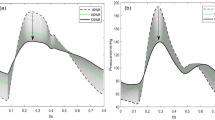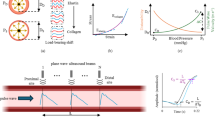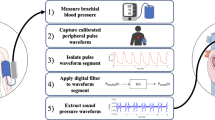Abstract
WORK upon Korotkov's sounds led me1 to the conclusion that the arterial system could be regarded as an energy transmission line, into which the heart launches energy at two levels, namely, waves with a frequency of 3–15 c.p.s. and waves with a frequency of 256–512 c.p.s. The theory required that the sound waves, resulting from forces of cavitation, be transmitted throughout the arteries, with a velocity much higher than that of the waves of low frequency, to explain the development of arterial stationary waves.
This is a preview of subscription content, access via your institution
Access options
Subscribe to this journal
Receive 51 print issues and online access
$199.00 per year
only $3.90 per issue
Buy this article
- Purchase on SpringerLink
- Instant access to full article PDF
Prices may be subject to local taxes which are calculated during checkout
Similar content being viewed by others
References
Malcolm, J. E., Blood Stood Pressure Sounds and their Meanings, Part 2, 7 (William Heinemann, Medical Books, Ltd., London, 1959).
Kerr, W. J., and Harp, jun., V. C., Amer. Heart J., 37, 100 (1949).
Citters, R. L. Van, Circulation Res., 8, 1145 (1960).
Landowne, M., J. App. Physiol., 12, 91 (1958).
Turrettini, G., Arch. mal. coeur, 15, 489 (1922).
McKusick, V. A., Cardiovascular Sound in Health and in Disease, 147 (Williams and Wilkins Co., Baltimore, 1958).
Levine, S. A., and Likoff, W. B., Ann. Intern. Med., 21, 298 (1944).
Malcolm, J. E., Nature, 186, 723 (1960).
Author information
Authors and Affiliations
Rights and permissions
About this article
Cite this article
MALCOLM, J. Korotkov's Sounds: a Function of the Skeleton to Transmit ‘Pulsactor’ Signals. Nature 190, 1114 (1961). https://doi.org/10.1038/1901114a0
Issue date:
DOI: https://doi.org/10.1038/1901114a0
This article is cited by
-
Die biophysikalischen Grundlagen der Mechanokardiographie
Archiv für Kreislaufforschung (1964)
-
Action of the Hypothalamus
Nature (1961)



